CHC43015 Certificate IV in Ageing Support - Assessment 1 Details
VerifiedAdded on 2021/09/10
|19
|5387
|303
Homework Assignment
AI Summary
This document presents a student's completed formative assessment for the CHC43015 Certificate IV in Ageing Support, specifically Assessment 1 which focuses on underpinning knowledge related to working with diverse people (CHCDIV001). The assignment includes responses to questions about cultural awareness, cultural groups, diverse attitudes, working with Aboriginal and Torres Strait Islander clients, and scenarios involving cultural differences. It explores topics like equal employment opportunities, language barriers, strategies to eliminate bias, and the importance of reflection and self-awareness in promoting inclusivity. The student also discusses the advantages and disadvantages of work relationships and completes a fill-in-the-blanks activity related to cultural competence. The assignment demonstrates an understanding of cultural sensitivity and the ability to apply this knowledge in a professional context within the aged care sector.
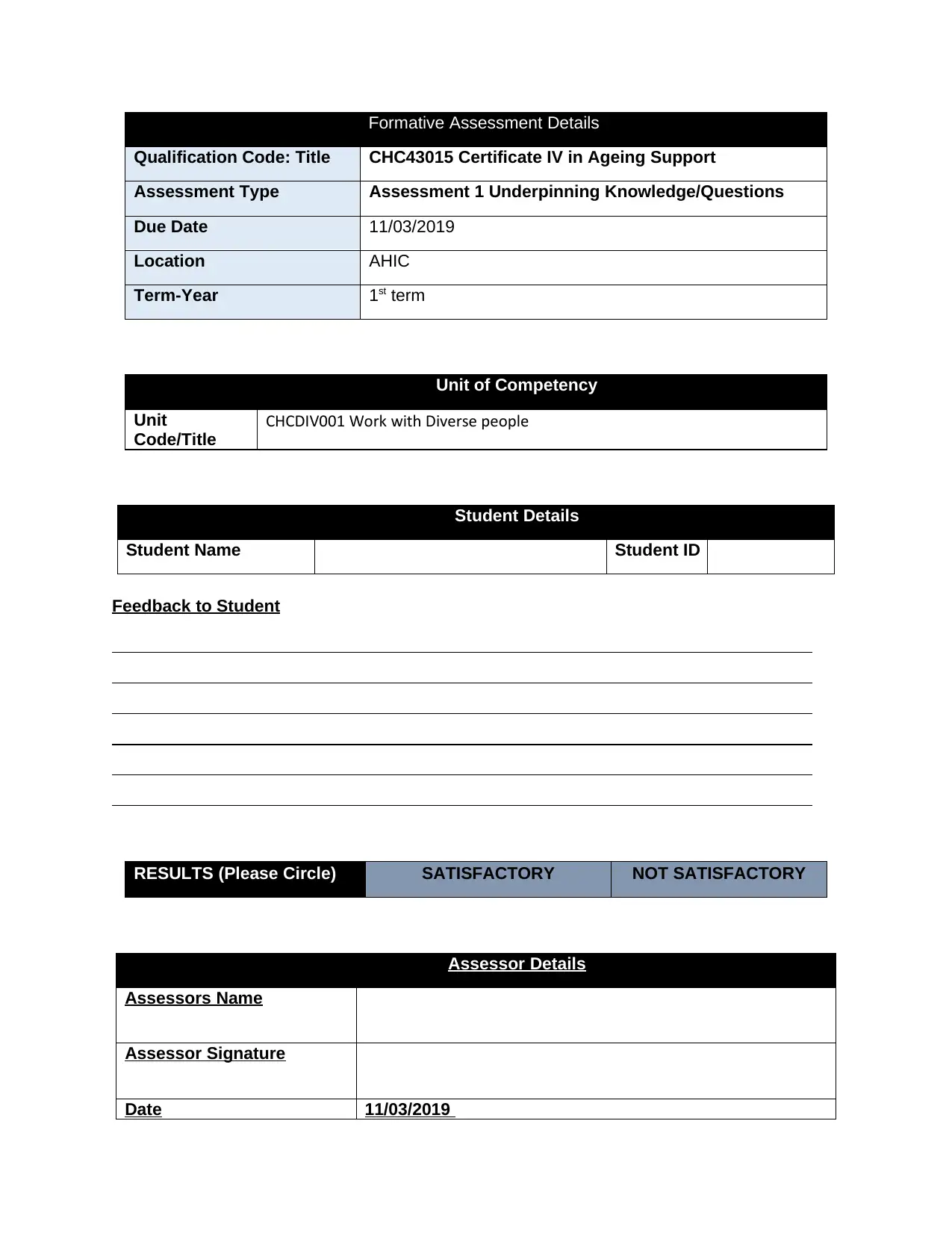
Formative Assessment Details
Qualification Code: Title CHC43015 Certificate IV in Ageing Support
Assessment Type Assessment 1 Underpinning Knowledge/Questions
Due Date 11/03/2019
Location AHIC
Term-Year 1st term
Unit of Competency
Unit
Code/Title
CHCDIV001 Work with Diverse people
Student Details
Student Name Student ID
Feedback to Student
RESULTS (Please Circle) SATISFACTORY NOT SATISFACTORY
Assessor Details
Assessors Name
Assessor Signature
Date 11/03/2019
Qualification Code: Title CHC43015 Certificate IV in Ageing Support
Assessment Type Assessment 1 Underpinning Knowledge/Questions
Due Date 11/03/2019
Location AHIC
Term-Year 1st term
Unit of Competency
Unit
Code/Title
CHCDIV001 Work with Diverse people
Student Details
Student Name Student ID
Feedback to Student
RESULTS (Please Circle) SATISFACTORY NOT SATISFACTORY
Assessor Details
Assessors Name
Assessor Signature
Date 11/03/2019
Paraphrase This Document
Need a fresh take? Get an instant paraphrase of this document with our AI Paraphraser

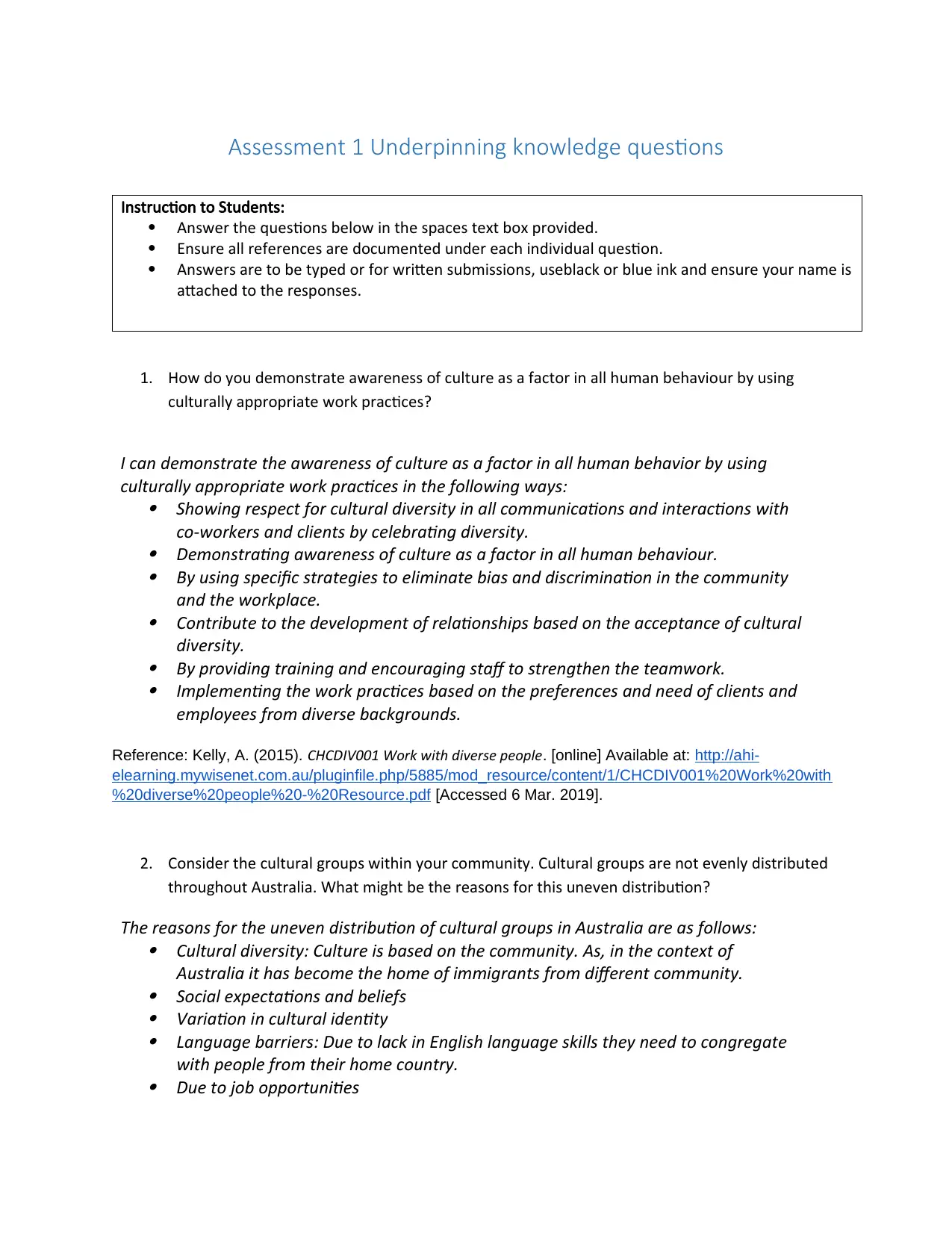
Assessment 1 Underpinning knowledge questions
Instruction to Students:
Answer the questions below in the spaces text box provided.
Ensure all references are documented under each individual question.
Answers are to be typed or for written submissions, useblack or blue ink and ensure your name is
attached to the responses.
1. How do you demonstrate awareness of culture as a factor in all human behaviour by using
culturally appropriate work practices?
I can demonstrate the awareness of culture as a factor in all human behavior by using
culturally appropriate work practices in the following ways:
Showing respect for cultural diversity in all communications and interactions with
co-workers and clients by celebrating diversity.
Demonstrating awareness of culture as a factor in all human behaviour.
By using specific strategies to eliminate bias and discrimination in the community
and the workplace.
Contribute to the development of relationships based on the acceptance of cultural
diversity.
By providing training and encouraging staff to strengthen the teamwork.
Implementing the work practices based on the preferences and need of clients and
employees from diverse backgrounds.
Reference: Kelly, A. (2015). CHCDIV001 Work with diverse people. [online] Available at: http://ahi-
elearning.mywisenet.com.au/pluginfile.php/5885/mod_resource/content/1/CHCDIV001%20Work%20with
%20diverse%20people%20-%20Resource.pdf [Accessed 6 Mar. 2019].
2. Consider the cultural groups within your community. Cultural groups are not evenly distributed
throughout Australia. What might be the reasons for this uneven distribution?
The reasons for the uneven distribution of cultural groups in Australia are as follows:
Cultural diversity: Culture is based on the community. As, in the context of
Australia it has become the home of immigrants from different community.
Social expectations and beliefs
Variation in cultural identity
Language barriers: Due to lack in English language skills they need to congregate
with people from their home country.
Due to job opportunities
Instruction to Students:
Answer the questions below in the spaces text box provided.
Ensure all references are documented under each individual question.
Answers are to be typed or for written submissions, useblack or blue ink and ensure your name is
attached to the responses.
1. How do you demonstrate awareness of culture as a factor in all human behaviour by using
culturally appropriate work practices?
I can demonstrate the awareness of culture as a factor in all human behavior by using
culturally appropriate work practices in the following ways:
Showing respect for cultural diversity in all communications and interactions with
co-workers and clients by celebrating diversity.
Demonstrating awareness of culture as a factor in all human behaviour.
By using specific strategies to eliminate bias and discrimination in the community
and the workplace.
Contribute to the development of relationships based on the acceptance of cultural
diversity.
By providing training and encouraging staff to strengthen the teamwork.
Implementing the work practices based on the preferences and need of clients and
employees from diverse backgrounds.
Reference: Kelly, A. (2015). CHCDIV001 Work with diverse people. [online] Available at: http://ahi-
elearning.mywisenet.com.au/pluginfile.php/5885/mod_resource/content/1/CHCDIV001%20Work%20with
%20diverse%20people%20-%20Resource.pdf [Accessed 6 Mar. 2019].
2. Consider the cultural groups within your community. Cultural groups are not evenly distributed
throughout Australia. What might be the reasons for this uneven distribution?
The reasons for the uneven distribution of cultural groups in Australia are as follows:
Cultural diversity: Culture is based on the community. As, in the context of
Australia it has become the home of immigrants from different community.
Social expectations and beliefs
Variation in cultural identity
Language barriers: Due to lack in English language skills they need to congregate
with people from their home country.
Due to job opportunities
⊘ This is a preview!⊘
Do you want full access?
Subscribe today to unlock all pages.

Trusted by 1+ million students worldwide
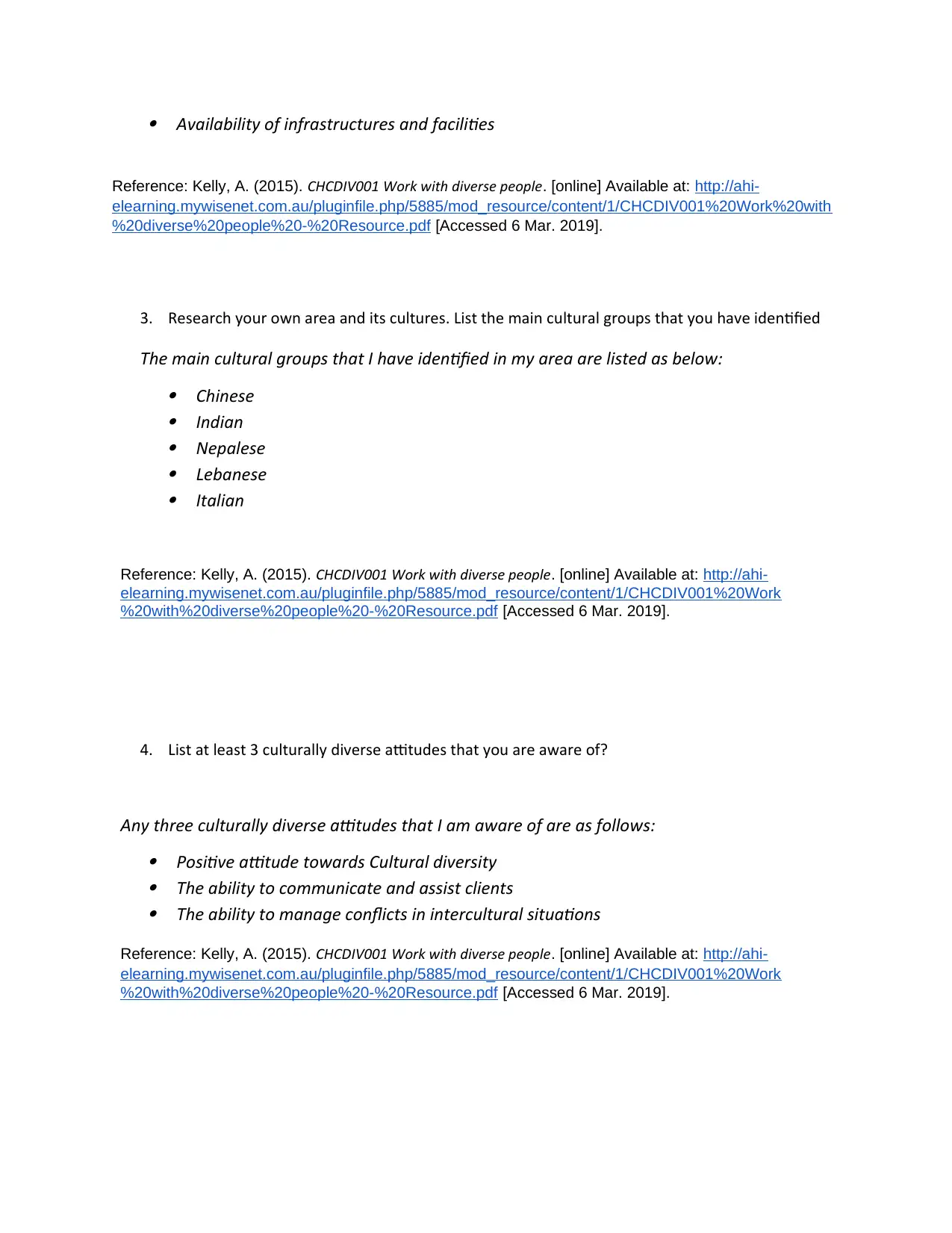
Availability of infrastructures and facilities
Reference: Kelly, A. (2015). CHCDIV001 Work with diverse people. [online] Available at: http://ahi-
elearning.mywisenet.com.au/pluginfile.php/5885/mod_resource/content/1/CHCDIV001%20Work%20with
%20diverse%20people%20-%20Resource.pdf [Accessed 6 Mar. 2019].
3. Research your own area and its cultures. List the main cultural groups that you have identified
The main cultural groups that I have identified in my area are listed as below: Chinese
Indian
Nepalese
Lebanese
Italian
Reference: Kelly, A. (2015). CHCDIV001 Work with diverse people. [online] Available at: http://ahi-
elearning.mywisenet.com.au/pluginfile.php/5885/mod_resource/content/1/CHCDIV001%20Work
%20with%20diverse%20people%20-%20Resource.pdf [Accessed 6 Mar. 2019].
4. List at least 3 culturally diverse attitudes that you are aware of?
Any three culturally diverse attitudes that I am aware of are as follows: Positive attitude towards Cultural diversity
The ability to communicate and assist clients
The ability to manage conflicts in intercultural situations
Reference: Kelly, A. (2015). CHCDIV001 Work with diverse people. [online] Available at: http://ahi-
elearning.mywisenet.com.au/pluginfile.php/5885/mod_resource/content/1/CHCDIV001%20Work
%20with%20diverse%20people%20-%20Resource.pdf [Accessed 6 Mar. 2019].
Reference: Kelly, A. (2015). CHCDIV001 Work with diverse people. [online] Available at: http://ahi-
elearning.mywisenet.com.au/pluginfile.php/5885/mod_resource/content/1/CHCDIV001%20Work%20with
%20diverse%20people%20-%20Resource.pdf [Accessed 6 Mar. 2019].
3. Research your own area and its cultures. List the main cultural groups that you have identified
The main cultural groups that I have identified in my area are listed as below: Chinese
Indian
Nepalese
Lebanese
Italian
Reference: Kelly, A. (2015). CHCDIV001 Work with diverse people. [online] Available at: http://ahi-
elearning.mywisenet.com.au/pluginfile.php/5885/mod_resource/content/1/CHCDIV001%20Work
%20with%20diverse%20people%20-%20Resource.pdf [Accessed 6 Mar. 2019].
4. List at least 3 culturally diverse attitudes that you are aware of?
Any three culturally diverse attitudes that I am aware of are as follows: Positive attitude towards Cultural diversity
The ability to communicate and assist clients
The ability to manage conflicts in intercultural situations
Reference: Kelly, A. (2015). CHCDIV001 Work with diverse people. [online] Available at: http://ahi-
elearning.mywisenet.com.au/pluginfile.php/5885/mod_resource/content/1/CHCDIV001%20Work
%20with%20diverse%20people%20-%20Resource.pdf [Accessed 6 Mar. 2019].
Paraphrase This Document
Need a fresh take? Get an instant paraphrase of this document with our AI Paraphraser
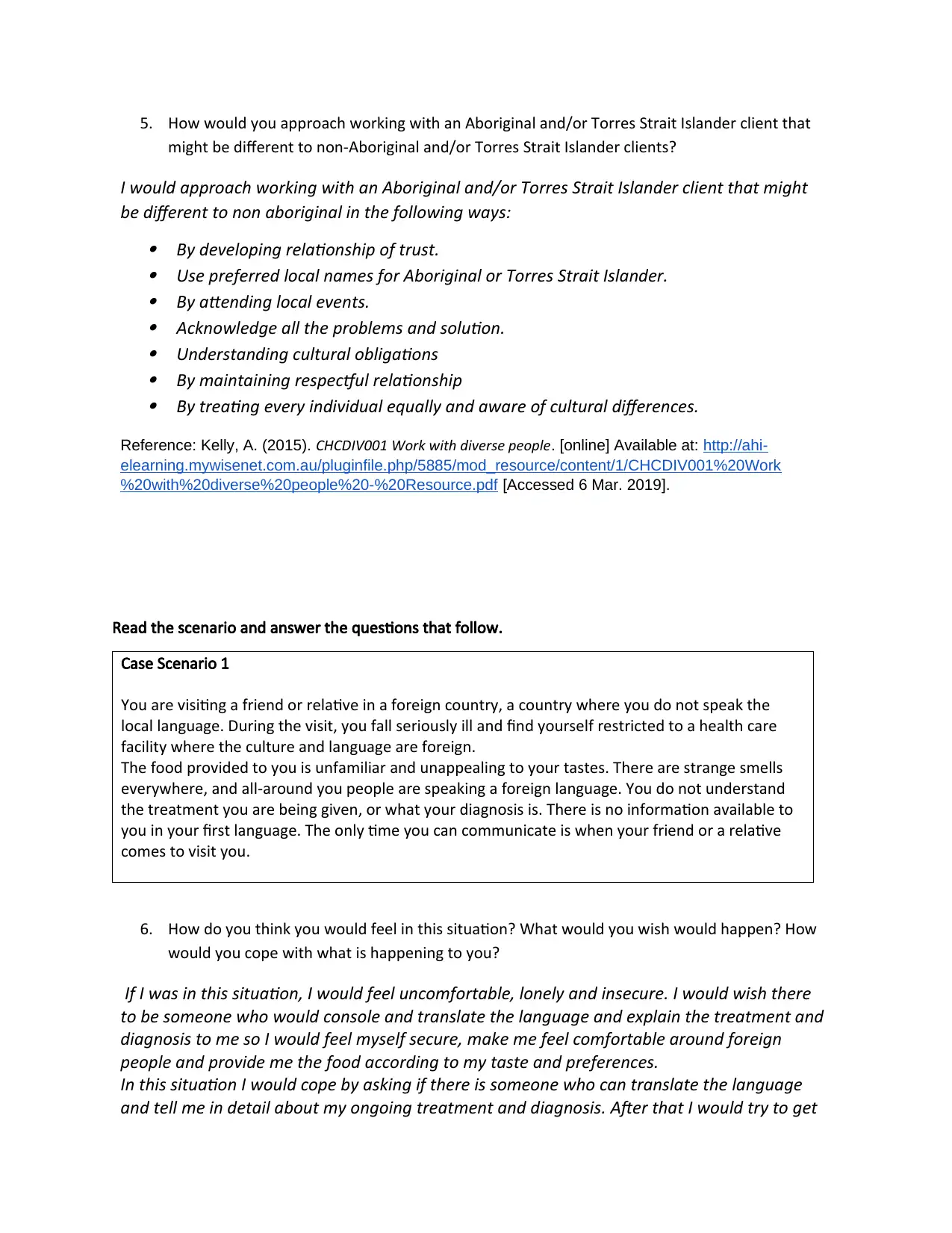
5. How would you approach working with an Aboriginal and/or Torres Strait Islander client that
might be different to non-Aboriginal and/or Torres Strait Islander clients?
I would approach working with an Aboriginal and/or Torres Strait Islander client that might
be different to non aboriginal in the following ways: By developing relationship of trust.
Use preferred local names for Aboriginal or Torres Strait Islander.
By attending local events.
Acknowledge all the problems and solution.
Understanding cultural obligations
By maintaining respectful relationship
By treating every individual equally and aware of cultural differences.
Reference: Kelly, A. (2015). CHCDIV001 Work with diverse people. [online] Available at: http://ahi-
elearning.mywisenet.com.au/pluginfile.php/5885/mod_resource/content/1/CHCDIV001%20Work
%20with%20diverse%20people%20-%20Resource.pdf [Accessed 6 Mar. 2019].
Read the scenario and answer the questions that follow.
Case Scenario 1
You are visiting a friend or relative in a foreign country, a country where you do not speak the
local language. During the visit, you fall seriously ill and find yourself restricted to a health care
facility where the culture and language are foreign.
The food provided to you is unfamiliar and unappealing to your tastes. There are strange smells
everywhere, and all-around you people are speaking a foreign language. You do not understand
the treatment you are being given, or what your diagnosis is. There is no information available to
you in your first language. The only time you can communicate is when your friend or a relative
comes to visit you.
6. How do you think you would feel in this situation? What would you wish would happen? How
would you cope with what is happening to you?
If I was in this situation, I would feel uncomfortable, lonely and insecure. I would wish there
to be someone who would console and translate the language and explain the treatment and
diagnosis to me so I would feel myself secure, make me feel comfortable around foreign
people and provide me the food according to my taste and preferences.
In this situation I would cope by asking if there is someone who can translate the language
and tell me in detail about my ongoing treatment and diagnosis. After that I would try to get
might be different to non-Aboriginal and/or Torres Strait Islander clients?
I would approach working with an Aboriginal and/or Torres Strait Islander client that might
be different to non aboriginal in the following ways: By developing relationship of trust.
Use preferred local names for Aboriginal or Torres Strait Islander.
By attending local events.
Acknowledge all the problems and solution.
Understanding cultural obligations
By maintaining respectful relationship
By treating every individual equally and aware of cultural differences.
Reference: Kelly, A. (2015). CHCDIV001 Work with diverse people. [online] Available at: http://ahi-
elearning.mywisenet.com.au/pluginfile.php/5885/mod_resource/content/1/CHCDIV001%20Work
%20with%20diverse%20people%20-%20Resource.pdf [Accessed 6 Mar. 2019].
Read the scenario and answer the questions that follow.
Case Scenario 1
You are visiting a friend or relative in a foreign country, a country where you do not speak the
local language. During the visit, you fall seriously ill and find yourself restricted to a health care
facility where the culture and language are foreign.
The food provided to you is unfamiliar and unappealing to your tastes. There are strange smells
everywhere, and all-around you people are speaking a foreign language. You do not understand
the treatment you are being given, or what your diagnosis is. There is no information available to
you in your first language. The only time you can communicate is when your friend or a relative
comes to visit you.
6. How do you think you would feel in this situation? What would you wish would happen? How
would you cope with what is happening to you?
If I was in this situation, I would feel uncomfortable, lonely and insecure. I would wish there
to be someone who would console and translate the language and explain the treatment and
diagnosis to me so I would feel myself secure, make me feel comfortable around foreign
people and provide me the food according to my taste and preferences.
In this situation I would cope by asking if there is someone who can translate the language
and tell me in detail about my ongoing treatment and diagnosis. After that I would try to get
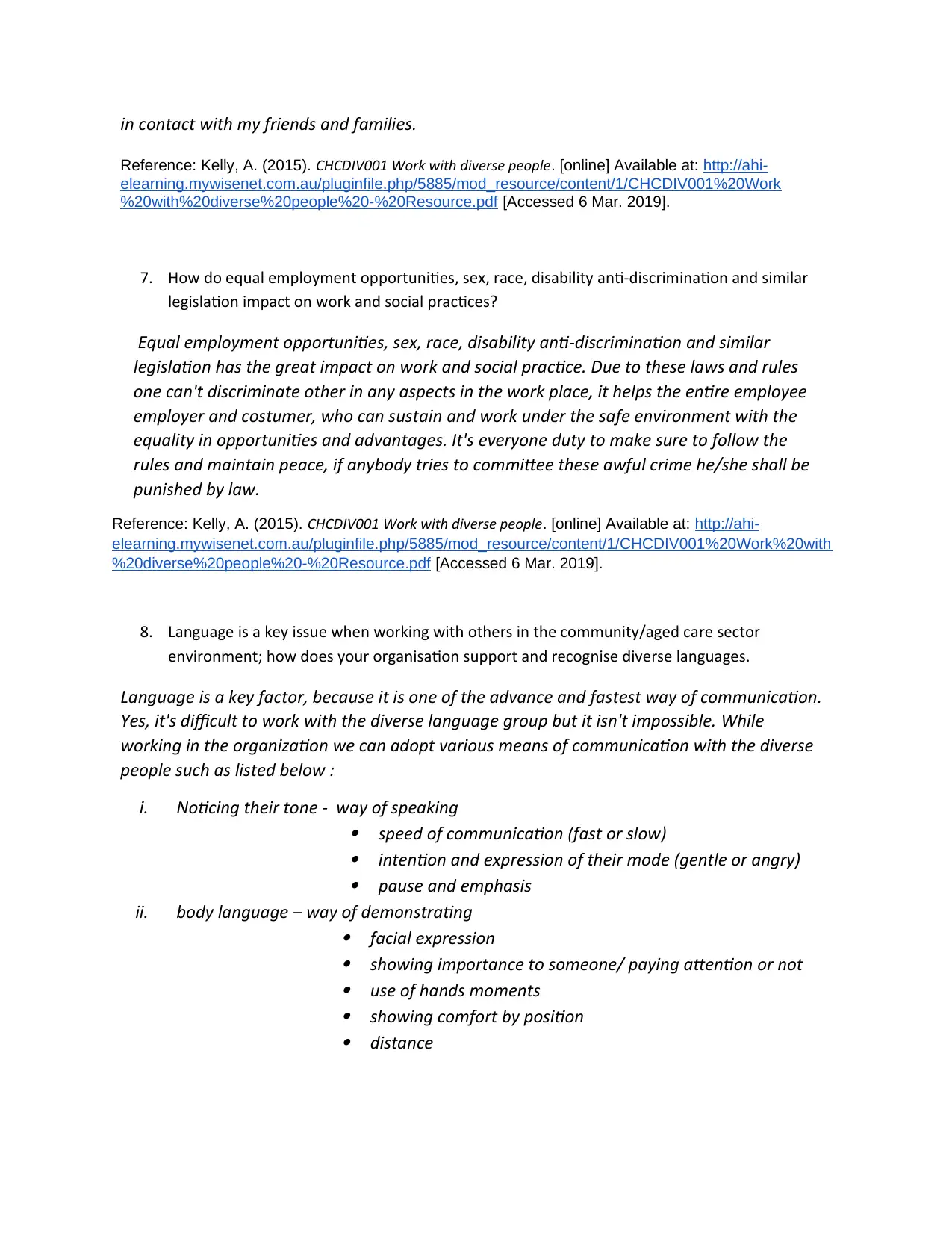
in contact with my friends and families.
Reference: Kelly, A. (2015). CHCDIV001 Work with diverse people. [online] Available at: http://ahi-
elearning.mywisenet.com.au/pluginfile.php/5885/mod_resource/content/1/CHCDIV001%20Work
%20with%20diverse%20people%20-%20Resource.pdf [Accessed 6 Mar. 2019].
7. How do equal employment opportunities, sex, race, disability anti-discrimination and similar
legislation impact on work and social practices?
Equal employment opportunities, sex, race, disability anti-discrimination and similar
legislation has the great impact on work and social practice. Due to these laws and rules
one can't discriminate other in any aspects in the work place, it helps the entire employee
employer and costumer, who can sustain and work under the safe environment with the
equality in opportunities and advantages. It's everyone duty to make sure to follow the
rules and maintain peace, if anybody tries to committee these awful crime he/she shall be
punished by law.
Reference: Kelly, A. (2015). CHCDIV001 Work with diverse people. [online] Available at: http://ahi-
elearning.mywisenet.com.au/pluginfile.php/5885/mod_resource/content/1/CHCDIV001%20Work%20with
%20diverse%20people%20-%20Resource.pdf [Accessed 6 Mar. 2019].
8. Language is a key issue when working with others in the community/aged care sector
environment; how does your organisation support and recognise diverse languages.
Language is a key factor, because it is one of the advance and fastest way of communication.
Yes, it's difficult to work with the diverse language group but it isn't impossible. While
working in the organization we can adopt various means of communication with the diverse
people such as listed below :
i. Noticing their tone - way of speaking
speed of communication (fast or slow)
intention and expression of their mode (gentle or angry)
pause and emphasis
ii. body language – way of demonstrating
facial expression
showing importance to someone/ paying attention or not
use of hands moments
showing comfort by position
distance
Reference: Kelly, A. (2015). CHCDIV001 Work with diverse people. [online] Available at: http://ahi-
elearning.mywisenet.com.au/pluginfile.php/5885/mod_resource/content/1/CHCDIV001%20Work
%20with%20diverse%20people%20-%20Resource.pdf [Accessed 6 Mar. 2019].
7. How do equal employment opportunities, sex, race, disability anti-discrimination and similar
legislation impact on work and social practices?
Equal employment opportunities, sex, race, disability anti-discrimination and similar
legislation has the great impact on work and social practice. Due to these laws and rules
one can't discriminate other in any aspects in the work place, it helps the entire employee
employer and costumer, who can sustain and work under the safe environment with the
equality in opportunities and advantages. It's everyone duty to make sure to follow the
rules and maintain peace, if anybody tries to committee these awful crime he/she shall be
punished by law.
Reference: Kelly, A. (2015). CHCDIV001 Work with diverse people. [online] Available at: http://ahi-
elearning.mywisenet.com.au/pluginfile.php/5885/mod_resource/content/1/CHCDIV001%20Work%20with
%20diverse%20people%20-%20Resource.pdf [Accessed 6 Mar. 2019].
8. Language is a key issue when working with others in the community/aged care sector
environment; how does your organisation support and recognise diverse languages.
Language is a key factor, because it is one of the advance and fastest way of communication.
Yes, it's difficult to work with the diverse language group but it isn't impossible. While
working in the organization we can adopt various means of communication with the diverse
people such as listed below :
i. Noticing their tone - way of speaking
speed of communication (fast or slow)
intention and expression of their mode (gentle or angry)
pause and emphasis
ii. body language – way of demonstrating
facial expression
showing importance to someone/ paying attention or not
use of hands moments
showing comfort by position
distance
⊘ This is a preview!⊘
Do you want full access?
Subscribe today to unlock all pages.

Trusted by 1+ million students worldwide
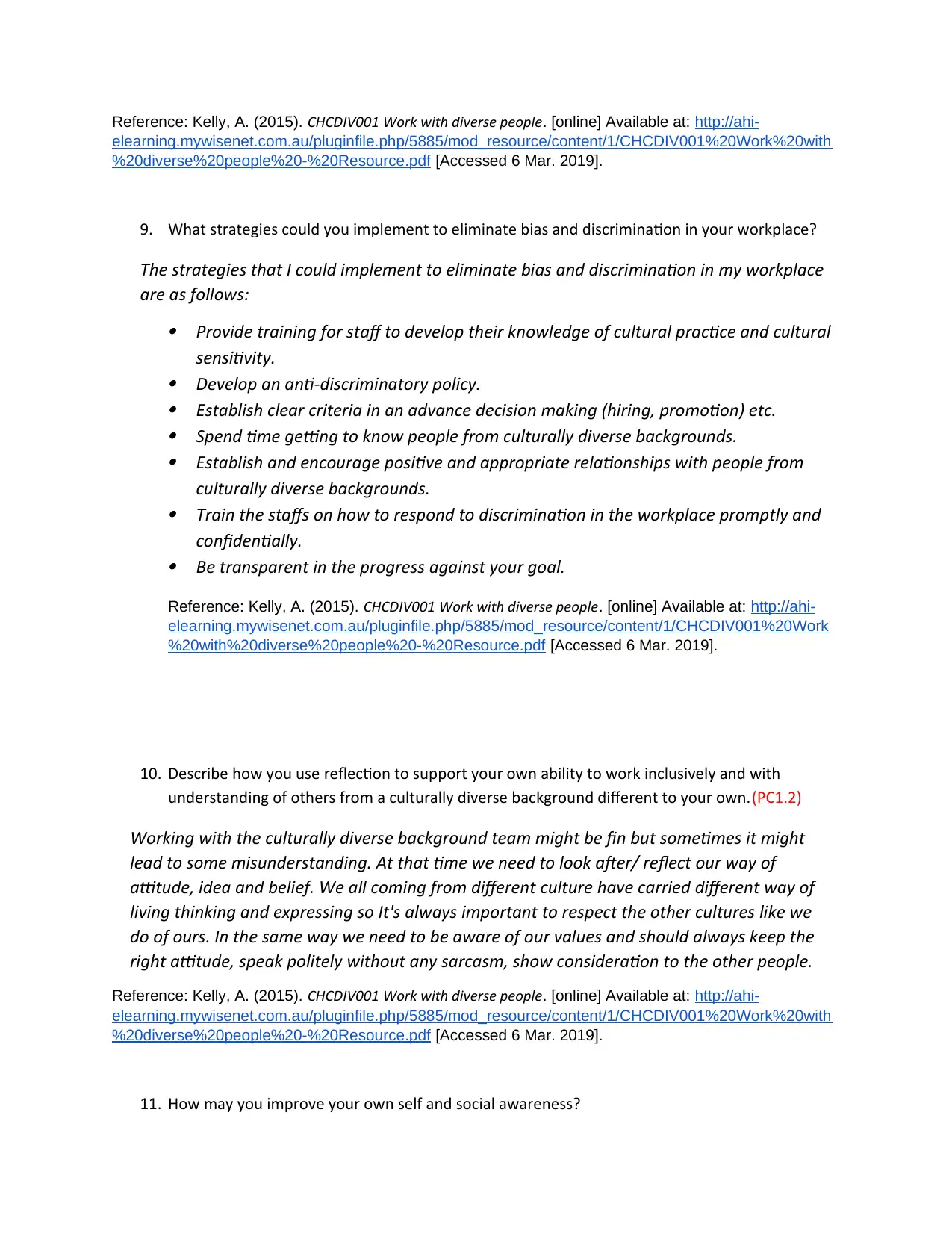
Reference: Kelly, A. (2015). CHCDIV001 Work with diverse people. [online] Available at: http://ahi-
elearning.mywisenet.com.au/pluginfile.php/5885/mod_resource/content/1/CHCDIV001%20Work%20with
%20diverse%20people%20-%20Resource.pdf [Accessed 6 Mar. 2019].
9. What strategies could you implement to eliminate bias and discrimination in your workplace?
The strategies that I could implement to eliminate bias and discrimination in my workplace
are as follows: Provide training for staff to develop their knowledge of cultural practice and cultural
sensitivity.
Develop an anti-discriminatory policy.
Establish clear criteria in an advance decision making (hiring, promotion) etc.
Spend time getting to know people from culturally diverse backgrounds.
Establish and encourage positive and appropriate relationships with people from
culturally diverse backgrounds.
Train the staffs on how to respond to discrimination in the workplace promptly and
confidentially.
Be transparent in the progress against your goal.
Reference: Kelly, A. (2015). CHCDIV001 Work with diverse people. [online] Available at: http://ahi-
elearning.mywisenet.com.au/pluginfile.php/5885/mod_resource/content/1/CHCDIV001%20Work
%20with%20diverse%20people%20-%20Resource.pdf [Accessed 6 Mar. 2019].
10. Describe how you use reflection to support your own ability to work inclusively and with
understanding of others from a culturally diverse background different to your own.(PC1.2)
Working with the culturally diverse background team might be fin but sometimes it might
lead to some misunderstanding. At that time we need to look after/ reflect our way of
attitude, idea and belief. We all coming from different culture have carried different way of
living thinking and expressing so It's always important to respect the other cultures like we
do of ours. In the same way we need to be aware of our values and should always keep the
right attitude, speak politely without any sarcasm, show consideration to the other people.
Reference: Kelly, A. (2015). CHCDIV001 Work with diverse people. [online] Available at: http://ahi-
elearning.mywisenet.com.au/pluginfile.php/5885/mod_resource/content/1/CHCDIV001%20Work%20with
%20diverse%20people%20-%20Resource.pdf [Accessed 6 Mar. 2019].
11. How may you improve your own self and social awareness?
elearning.mywisenet.com.au/pluginfile.php/5885/mod_resource/content/1/CHCDIV001%20Work%20with
%20diverse%20people%20-%20Resource.pdf [Accessed 6 Mar. 2019].
9. What strategies could you implement to eliminate bias and discrimination in your workplace?
The strategies that I could implement to eliminate bias and discrimination in my workplace
are as follows: Provide training for staff to develop their knowledge of cultural practice and cultural
sensitivity.
Develop an anti-discriminatory policy.
Establish clear criteria in an advance decision making (hiring, promotion) etc.
Spend time getting to know people from culturally diverse backgrounds.
Establish and encourage positive and appropriate relationships with people from
culturally diverse backgrounds.
Train the staffs on how to respond to discrimination in the workplace promptly and
confidentially.
Be transparent in the progress against your goal.
Reference: Kelly, A. (2015). CHCDIV001 Work with diverse people. [online] Available at: http://ahi-
elearning.mywisenet.com.au/pluginfile.php/5885/mod_resource/content/1/CHCDIV001%20Work
%20with%20diverse%20people%20-%20Resource.pdf [Accessed 6 Mar. 2019].
10. Describe how you use reflection to support your own ability to work inclusively and with
understanding of others from a culturally diverse background different to your own.(PC1.2)
Working with the culturally diverse background team might be fin but sometimes it might
lead to some misunderstanding. At that time we need to look after/ reflect our way of
attitude, idea and belief. We all coming from different culture have carried different way of
living thinking and expressing so It's always important to respect the other cultures like we
do of ours. In the same way we need to be aware of our values and should always keep the
right attitude, speak politely without any sarcasm, show consideration to the other people.
Reference: Kelly, A. (2015). CHCDIV001 Work with diverse people. [online] Available at: http://ahi-
elearning.mywisenet.com.au/pluginfile.php/5885/mod_resource/content/1/CHCDIV001%20Work%20with
%20diverse%20people%20-%20Resource.pdf [Accessed 6 Mar. 2019].
11. How may you improve your own self and social awareness?
Paraphrase This Document
Need a fresh take? Get an instant paraphrase of this document with our AI Paraphraser
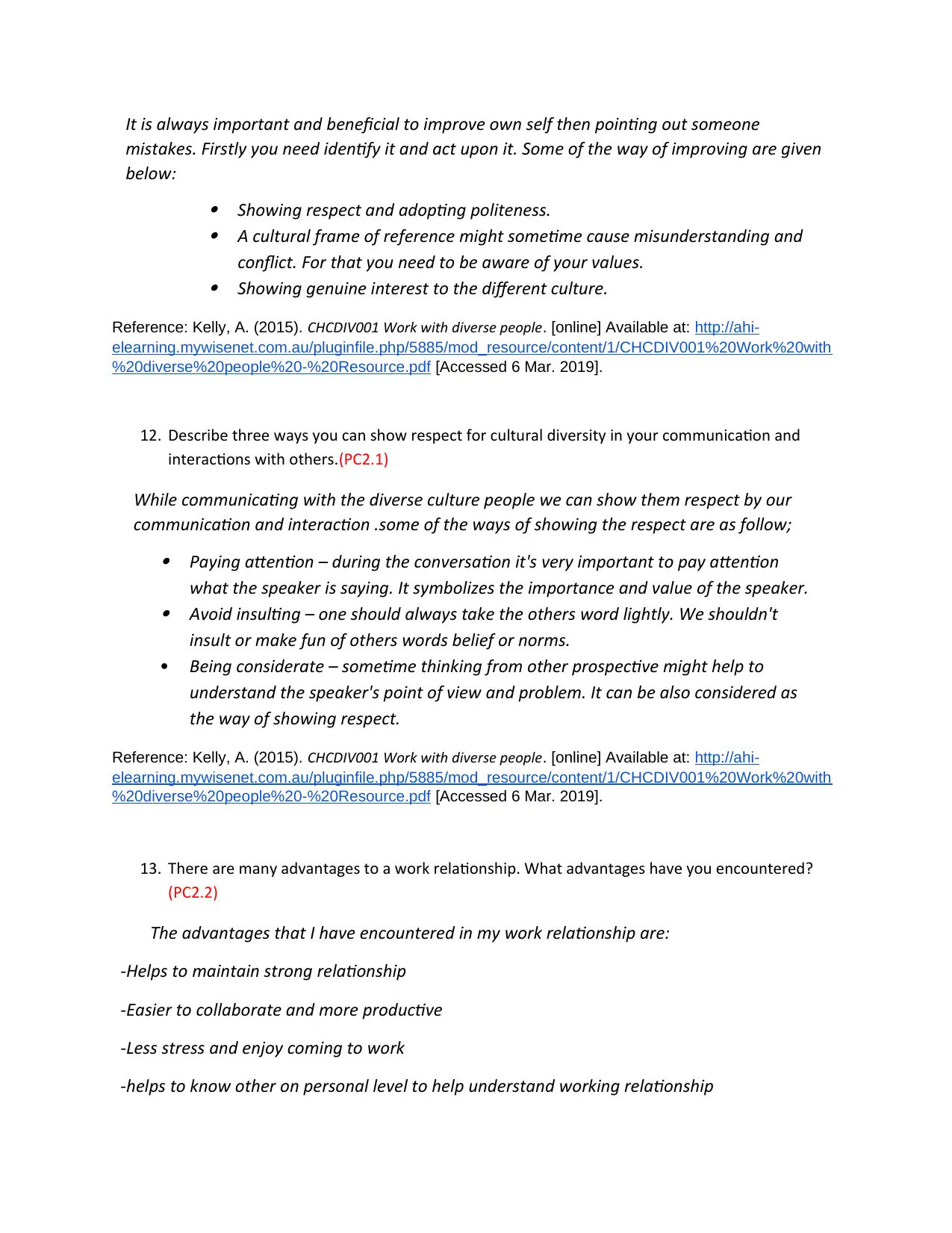
It is always important and beneficial to improve own self then pointing out someone
mistakes. Firstly you need identify it and act upon it. Some of the way of improving are given
below:
Showing respect and adopting politeness.
A cultural frame of reference might sometime cause misunderstanding and
conflict. For that you need to be aware of your values.
Showing genuine interest to the different culture.
Reference: Kelly, A. (2015). CHCDIV001 Work with diverse people. [online] Available at: http://ahi-
elearning.mywisenet.com.au/pluginfile.php/5885/mod_resource/content/1/CHCDIV001%20Work%20with
%20diverse%20people%20-%20Resource.pdf [Accessed 6 Mar. 2019].
12. Describe three ways you can show respect for cultural diversity in your communication and
interactions with others.(PC2.1)
While communicating with the diverse culture people we can show them respect by our
communication and interaction .some of the ways of showing the respect are as follow; Paying attention – during the conversation it's very important to pay attention
what the speaker is saying. It symbolizes the importance and value of the speaker.
Avoid insulting – one should always take the others word lightly. We shouldn't
insult or make fun of others words belief or norms.
Being considerate – sometime thinking from other prospective might help to
understand the speaker's point of view and problem. It can be also considered as
the way of showing respect.
Reference: Kelly, A. (2015). CHCDIV001 Work with diverse people. [online] Available at: http://ahi-
elearning.mywisenet.com.au/pluginfile.php/5885/mod_resource/content/1/CHCDIV001%20Work%20with
%20diverse%20people%20-%20Resource.pdf [Accessed 6 Mar. 2019].
13. There are many advantages to a work relationship. What advantages have you encountered?
(PC2.2)
The advantages that I have encountered in my work relationship are:
-Helps to maintain strong relationship
-Easier to collaborate and more productive
-Less stress and enjoy coming to work
-helps to know other on personal level to help understand working relationship
mistakes. Firstly you need identify it and act upon it. Some of the way of improving are given
below:
Showing respect and adopting politeness.
A cultural frame of reference might sometime cause misunderstanding and
conflict. For that you need to be aware of your values.
Showing genuine interest to the different culture.
Reference: Kelly, A. (2015). CHCDIV001 Work with diverse people. [online] Available at: http://ahi-
elearning.mywisenet.com.au/pluginfile.php/5885/mod_resource/content/1/CHCDIV001%20Work%20with
%20diverse%20people%20-%20Resource.pdf [Accessed 6 Mar. 2019].
12. Describe three ways you can show respect for cultural diversity in your communication and
interactions with others.(PC2.1)
While communicating with the diverse culture people we can show them respect by our
communication and interaction .some of the ways of showing the respect are as follow; Paying attention – during the conversation it's very important to pay attention
what the speaker is saying. It symbolizes the importance and value of the speaker.
Avoid insulting – one should always take the others word lightly. We shouldn't
insult or make fun of others words belief or norms.
Being considerate – sometime thinking from other prospective might help to
understand the speaker's point of view and problem. It can be also considered as
the way of showing respect.
Reference: Kelly, A. (2015). CHCDIV001 Work with diverse people. [online] Available at: http://ahi-
elearning.mywisenet.com.au/pluginfile.php/5885/mod_resource/content/1/CHCDIV001%20Work%20with
%20diverse%20people%20-%20Resource.pdf [Accessed 6 Mar. 2019].
13. There are many advantages to a work relationship. What advantages have you encountered?
(PC2.2)
The advantages that I have encountered in my work relationship are:
-Helps to maintain strong relationship
-Easier to collaborate and more productive
-Less stress and enjoy coming to work
-helps to know other on personal level to help understand working relationship
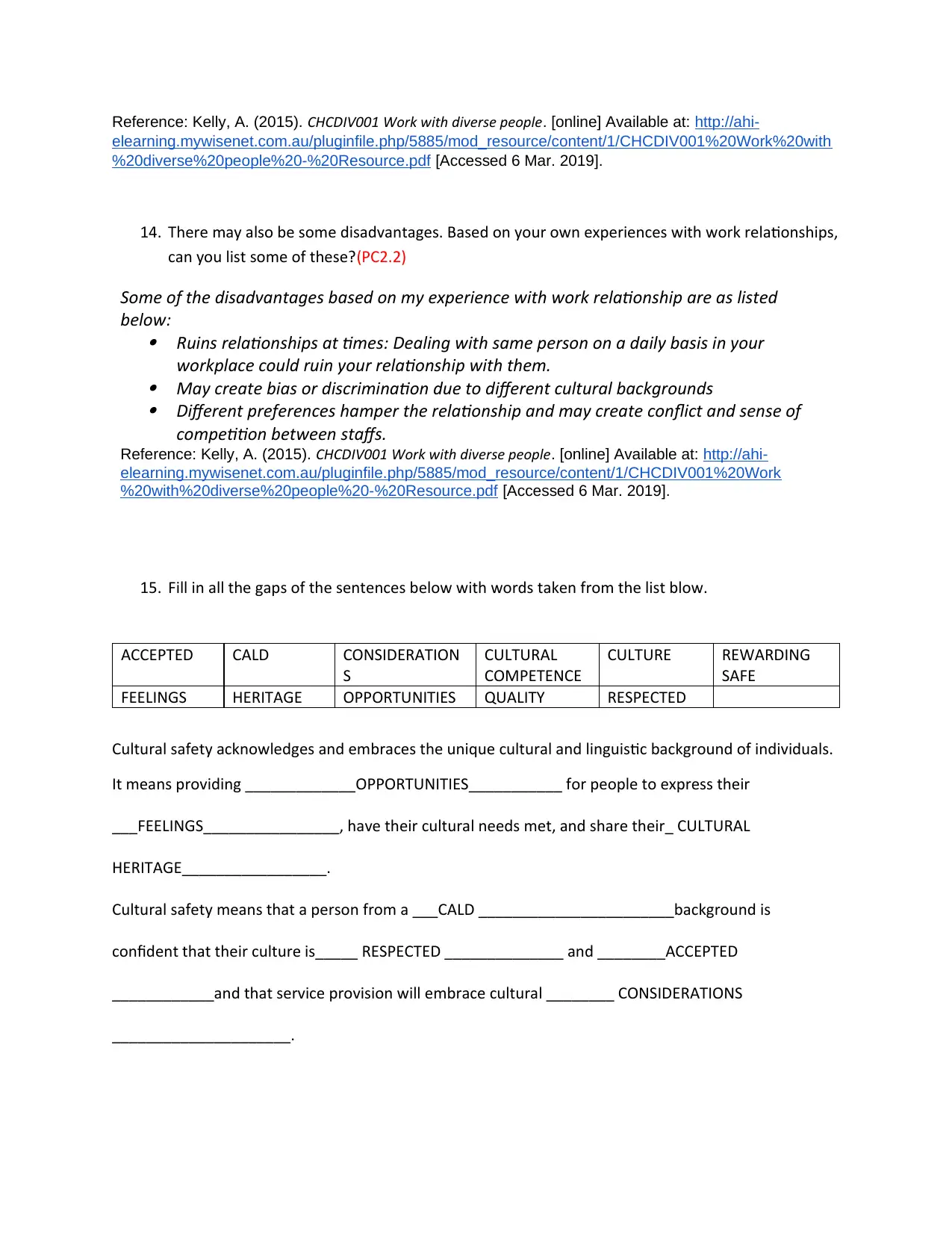
Reference: Kelly, A. (2015). CHCDIV001 Work with diverse people. [online] Available at: http://ahi-
elearning.mywisenet.com.au/pluginfile.php/5885/mod_resource/content/1/CHCDIV001%20Work%20with
%20diverse%20people%20-%20Resource.pdf [Accessed 6 Mar. 2019].
14. There may also be some disadvantages. Based on your own experiences with work relationships,
can you list some of these?(PC2.2)
Some of the disadvantages based on my experience with work relationship are as listed
below:
Ruins relationships at times: Dealing with same person on a daily basis in your
workplace could ruin your relationship with them.
May create bias or discrimination due to different cultural backgrounds
Different preferences hamper the relationship and may create conflict and sense of
competition between staffs.
Reference: Kelly, A. (2015). CHCDIV001 Work with diverse people. [online] Available at: http://ahi-
elearning.mywisenet.com.au/pluginfile.php/5885/mod_resource/content/1/CHCDIV001%20Work
%20with%20diverse%20people%20-%20Resource.pdf [Accessed 6 Mar. 2019].
15. Fill in all the gaps of the sentences below with words taken from the list blow.
ACCEPTED CALD CONSIDERATION
S
CULTURAL
COMPETENCE
CULTURE REWARDING
SAFE
FEELINGS HERITAGE OPPORTUNITIES QUALITY RESPECTED
Cultural safety acknowledges and embraces the unique cultural and linguistic background of individuals.
It means providing _____________OPPORTUNITIES___________ for people to express their
___FEELINGS________________, have their cultural needs met, and share their_ CULTURAL
HERITAGE_________________.
Cultural safety means that a person from a ___CALD _______________________background is
confident that their culture is_____ RESPECTED ______________ and ________ACCEPTED
____________and that service provision will embrace cultural ________ CONSIDERATIONS
_____________________.
elearning.mywisenet.com.au/pluginfile.php/5885/mod_resource/content/1/CHCDIV001%20Work%20with
%20diverse%20people%20-%20Resource.pdf [Accessed 6 Mar. 2019].
14. There may also be some disadvantages. Based on your own experiences with work relationships,
can you list some of these?(PC2.2)
Some of the disadvantages based on my experience with work relationship are as listed
below:
Ruins relationships at times: Dealing with same person on a daily basis in your
workplace could ruin your relationship with them.
May create bias or discrimination due to different cultural backgrounds
Different preferences hamper the relationship and may create conflict and sense of
competition between staffs.
Reference: Kelly, A. (2015). CHCDIV001 Work with diverse people. [online] Available at: http://ahi-
elearning.mywisenet.com.au/pluginfile.php/5885/mod_resource/content/1/CHCDIV001%20Work
%20with%20diverse%20people%20-%20Resource.pdf [Accessed 6 Mar. 2019].
15. Fill in all the gaps of the sentences below with words taken from the list blow.
ACCEPTED CALD CONSIDERATION
S
CULTURAL
COMPETENCE
CULTURE REWARDING
SAFE
FEELINGS HERITAGE OPPORTUNITIES QUALITY RESPECTED
Cultural safety acknowledges and embraces the unique cultural and linguistic background of individuals.
It means providing _____________OPPORTUNITIES___________ for people to express their
___FEELINGS________________, have their cultural needs met, and share their_ CULTURAL
HERITAGE_________________.
Cultural safety means that a person from a ___CALD _______________________background is
confident that their culture is_____ RESPECTED ______________ and ________ACCEPTED
____________and that service provision will embrace cultural ________ CONSIDERATIONS
_____________________.
⊘ This is a preview!⊘
Do you want full access?
Subscribe today to unlock all pages.

Trusted by 1+ million students worldwide

Clients’_______ CULTURE _______________________ of cultural safety are part of what_____
CULTURAL COMPETENCE _____________ is all about.
When our clients feel culturally _____ SAFE ___________________, their_____ QUALITY
_______________ of life improves and our work becomes more ________ REWARDING
_________________and enjoyable.
Reference: Kelly, A. (2015). CHCDIV001 Work with diverse people. [online] Available at: http://ahi-
elearning.mywisenet.com.au/pluginfile.php/5885/mod_resource/content/1/CHCDIV001%20Work%20with
%20diverse%20people%20-%20Resource.pdf [Accessed 6 Mar. 2019].
16. In this activity you will revise the concept of cultural competence. As you work through this
activity, think of what each statement means in your workplace.
Concepts of cultural competence TRUE FALSE
Culture may be defined as the way of life and world view of a particular group of
people at a particular point in time.
☐
The word competence implies the capacity to function effectively; being capable. ☐
Cultural competence refers to the ability to function effectively in cross-cultural
situations.
☐
Cultural competence doesn’t involve the ability to effectively interact with clients
and co-workers from a different cultural background to our own.
☐
Cultural competence only refers to white, Anglo-Australians working with people
who do not speak English.
☐
Cultural competence refers to all people working and interacting with anyone from
a cultural or linguistic background different to their own.
☐
The underlying principle of cultural competence is seeing the differences between
people from a positive perspective.
☐
No matter how culturally competent we may become, there will always be room
for improvement.
☐
Culturally competent work practices do not involve using a person’s culture as a
resource.
☐
Awareness of one’s own culture is not necessary for cultural competence. ☐
Cultural beliefs impact health beliefs and help seeking behaviour. ☐
Cultural competence involves enabling the client to adapt to our way of doing
things.
☐
Culturally competent practices are needed to comply with duty of care policies. ☐
CULTURAL COMPETENCE _____________ is all about.
When our clients feel culturally _____ SAFE ___________________, their_____ QUALITY
_______________ of life improves and our work becomes more ________ REWARDING
_________________and enjoyable.
Reference: Kelly, A. (2015). CHCDIV001 Work with diverse people. [online] Available at: http://ahi-
elearning.mywisenet.com.au/pluginfile.php/5885/mod_resource/content/1/CHCDIV001%20Work%20with
%20diverse%20people%20-%20Resource.pdf [Accessed 6 Mar. 2019].
16. In this activity you will revise the concept of cultural competence. As you work through this
activity, think of what each statement means in your workplace.
Concepts of cultural competence TRUE FALSE
Culture may be defined as the way of life and world view of a particular group of
people at a particular point in time.
☐
The word competence implies the capacity to function effectively; being capable. ☐
Cultural competence refers to the ability to function effectively in cross-cultural
situations.
☐
Cultural competence doesn’t involve the ability to effectively interact with clients
and co-workers from a different cultural background to our own.
☐
Cultural competence only refers to white, Anglo-Australians working with people
who do not speak English.
☐
Cultural competence refers to all people working and interacting with anyone from
a cultural or linguistic background different to their own.
☐
The underlying principle of cultural competence is seeing the differences between
people from a positive perspective.
☐
No matter how culturally competent we may become, there will always be room
for improvement.
☐
Culturally competent work practices do not involve using a person’s culture as a
resource.
☐
Awareness of one’s own culture is not necessary for cultural competence. ☐
Cultural beliefs impact health beliefs and help seeking behaviour. ☐
Cultural competence involves enabling the client to adapt to our way of doing
things.
☐
Culturally competent practices are needed to comply with duty of care policies. ☐
Paraphrase This Document
Need a fresh take? Get an instant paraphrase of this document with our AI Paraphraser
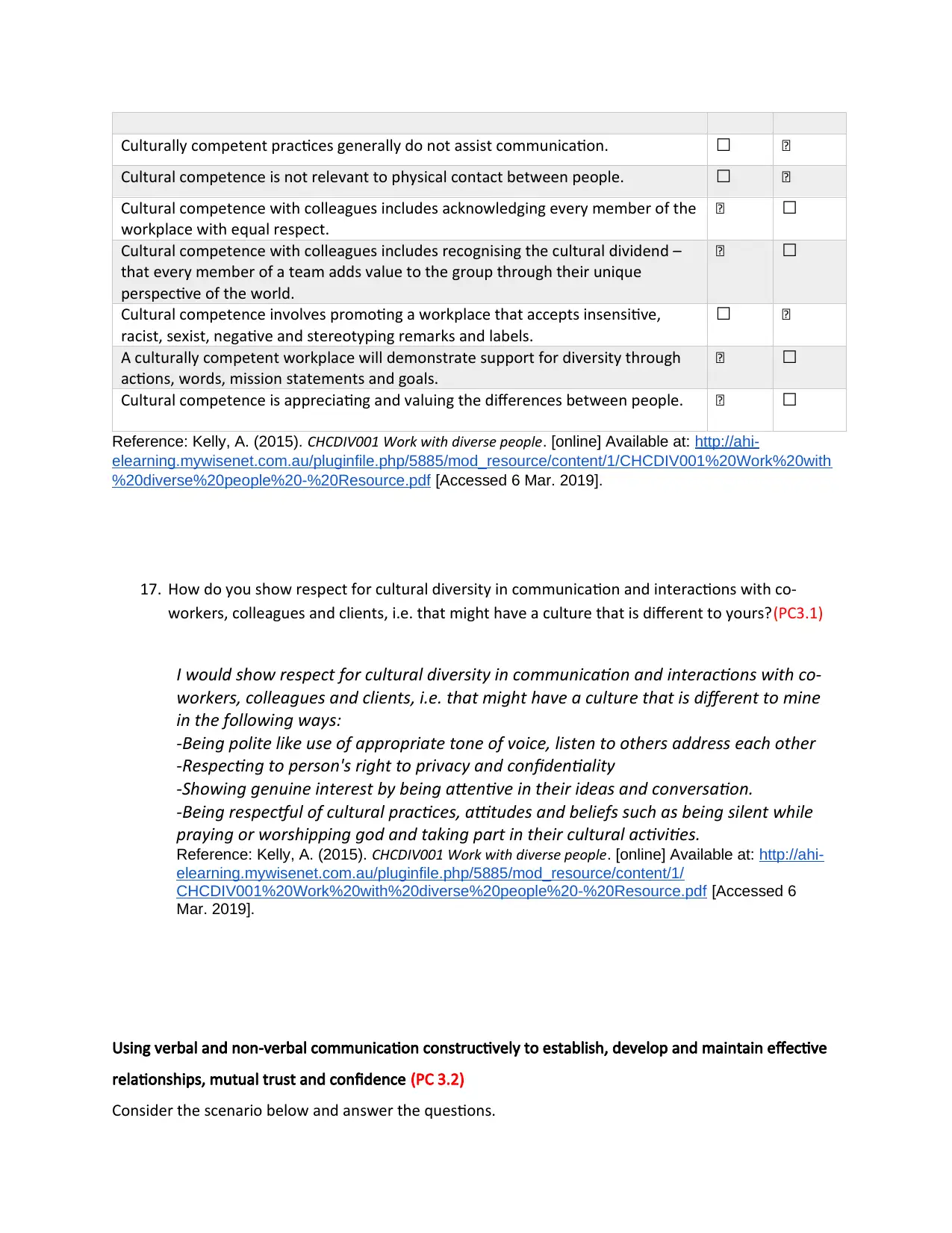
Culturally competent practices generally do not assist communication. ☐
Cultural competence is not relevant to physical contact between people. ☐
Cultural competence with colleagues includes acknowledging every member of the
workplace with equal respect.
☐
Cultural competence with colleagues includes recognising the cultural dividend –
that every member of a team adds value to the group through their unique
perspective of the world.
☐
Cultural competence involves promoting a workplace that accepts insensitive,
racist, sexist, negative and stereotyping remarks and labels.
☐
A culturally competent workplace will demonstrate support for diversity through
actions, words, mission statements and goals.
☐
Cultural competence is appreciating and valuing the differences between people. ☐
Reference: Kelly, A. (2015). CHCDIV001 Work with diverse people. [online] Available at: http://ahi-
elearning.mywisenet.com.au/pluginfile.php/5885/mod_resource/content/1/CHCDIV001%20Work%20with
%20diverse%20people%20-%20Resource.pdf [Accessed 6 Mar. 2019].
17. How do you show respect for cultural diversity in communication and interactions with co-
workers, colleagues and clients, i.e. that might have a culture that is different to yours?(PC3.1)
I would show respect for cultural diversity in communication and interactions with co-
workers, colleagues and clients, i.e. that might have a culture that is different to mine
in the following ways:
-Being polite like use of appropriate tone of voice, listen to others address each other
-Respecting to person's right to privacy and confidentiality
-Showing genuine interest by being attentive in their ideas and conversation.
-Being respectful of cultural practices, attitudes and beliefs such as being silent while
praying or worshipping god and taking part in their cultural activities.
Reference: Kelly, A. (2015). CHCDIV001 Work with diverse people. [online] Available at: http://ahi-
elearning.mywisenet.com.au/pluginfile.php/5885/mod_resource/content/1/
CHCDIV001%20Work%20with%20diverse%20people%20-%20Resource.pdf [Accessed 6
Mar. 2019].
Using verbal and non-verbal communication constructively to establish, develop and maintain effective
relationships, mutual trust and confidence (PC 3.2)
Consider the scenario below and answer the questions.
Cultural competence is not relevant to physical contact between people. ☐
Cultural competence with colleagues includes acknowledging every member of the
workplace with equal respect.
☐
Cultural competence with colleagues includes recognising the cultural dividend –
that every member of a team adds value to the group through their unique
perspective of the world.
☐
Cultural competence involves promoting a workplace that accepts insensitive,
racist, sexist, negative and stereotyping remarks and labels.
☐
A culturally competent workplace will demonstrate support for diversity through
actions, words, mission statements and goals.
☐
Cultural competence is appreciating and valuing the differences between people. ☐
Reference: Kelly, A. (2015). CHCDIV001 Work with diverse people. [online] Available at: http://ahi-
elearning.mywisenet.com.au/pluginfile.php/5885/mod_resource/content/1/CHCDIV001%20Work%20with
%20diverse%20people%20-%20Resource.pdf [Accessed 6 Mar. 2019].
17. How do you show respect for cultural diversity in communication and interactions with co-
workers, colleagues and clients, i.e. that might have a culture that is different to yours?(PC3.1)
I would show respect for cultural diversity in communication and interactions with co-
workers, colleagues and clients, i.e. that might have a culture that is different to mine
in the following ways:
-Being polite like use of appropriate tone of voice, listen to others address each other
-Respecting to person's right to privacy and confidentiality
-Showing genuine interest by being attentive in their ideas and conversation.
-Being respectful of cultural practices, attitudes and beliefs such as being silent while
praying or worshipping god and taking part in their cultural activities.
Reference: Kelly, A. (2015). CHCDIV001 Work with diverse people. [online] Available at: http://ahi-
elearning.mywisenet.com.au/pluginfile.php/5885/mod_resource/content/1/
CHCDIV001%20Work%20with%20diverse%20people%20-%20Resource.pdf [Accessed 6
Mar. 2019].
Using verbal and non-verbal communication constructively to establish, develop and maintain effective
relationships, mutual trust and confidence (PC 3.2)
Consider the scenario below and answer the questions.
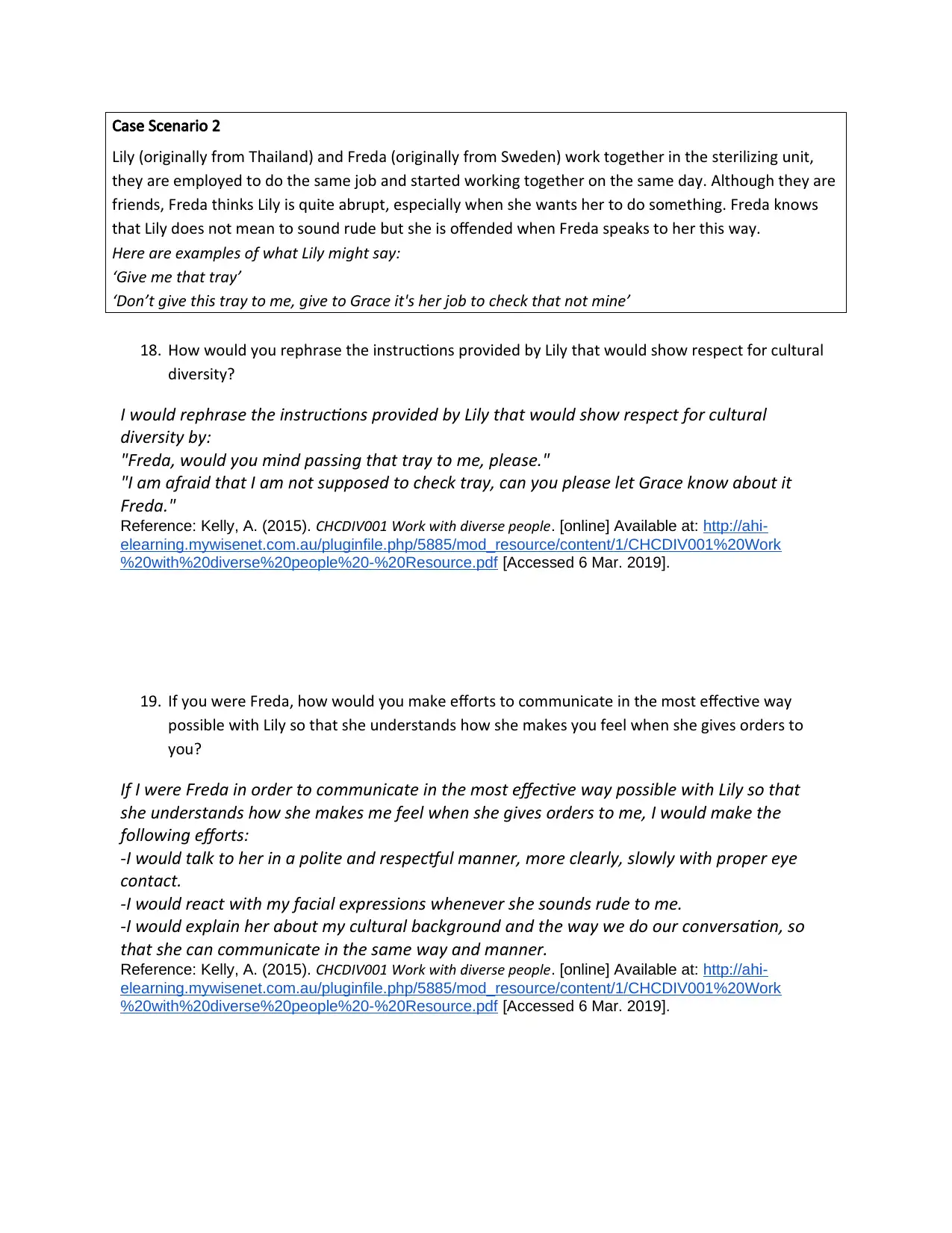
Case Scenario 2
Lily (originally from Thailand) and Freda (originally from Sweden) work together in the sterilizing unit,
they are employed to do the same job and started working together on the same day. Although they are
friends, Freda thinks Lily is quite abrupt, especially when she wants her to do something. Freda knows
that Lily does not mean to sound rude but she is offended when Freda speaks to her this way.
Here are examples of what Lily might say:
‘Give me that tray’
‘Don’t give this tray to me, give to Grace it's her job to check that not mine’
18. How would you rephrase the instructions provided by Lily that would show respect for cultural
diversity?
I would rephrase the instructions provided by Lily that would show respect for cultural
diversity by:
"Freda, would you mind passing that tray to me, please."
"I am afraid that I am not supposed to check tray, can you please let Grace know about it
Freda."
Reference: Kelly, A. (2015). CHCDIV001 Work with diverse people. [online] Available at: http://ahi-
elearning.mywisenet.com.au/pluginfile.php/5885/mod_resource/content/1/CHCDIV001%20Work
%20with%20diverse%20people%20-%20Resource.pdf [Accessed 6 Mar. 2019].
19. If you were Freda, how would you make efforts to communicate in the most effective way
possible with Lily so that she understands how she makes you feel when she gives orders to
you?
If I were Freda in order to communicate in the most effective way possible with Lily so that
she understands how she makes me feel when she gives orders to me, I would make the
following efforts:
-I would talk to her in a polite and respectful manner, more clearly, slowly with proper eye
contact.
-I would react with my facial expressions whenever she sounds rude to me.
-I would explain her about my cultural background and the way we do our conversation, so
that she can communicate in the same way and manner.
Reference: Kelly, A. (2015). CHCDIV001 Work with diverse people. [online] Available at: http://ahi-
elearning.mywisenet.com.au/pluginfile.php/5885/mod_resource/content/1/CHCDIV001%20Work
%20with%20diverse%20people%20-%20Resource.pdf [Accessed 6 Mar. 2019].
Lily (originally from Thailand) and Freda (originally from Sweden) work together in the sterilizing unit,
they are employed to do the same job and started working together on the same day. Although they are
friends, Freda thinks Lily is quite abrupt, especially when she wants her to do something. Freda knows
that Lily does not mean to sound rude but she is offended when Freda speaks to her this way.
Here are examples of what Lily might say:
‘Give me that tray’
‘Don’t give this tray to me, give to Grace it's her job to check that not mine’
18. How would you rephrase the instructions provided by Lily that would show respect for cultural
diversity?
I would rephrase the instructions provided by Lily that would show respect for cultural
diversity by:
"Freda, would you mind passing that tray to me, please."
"I am afraid that I am not supposed to check tray, can you please let Grace know about it
Freda."
Reference: Kelly, A. (2015). CHCDIV001 Work with diverse people. [online] Available at: http://ahi-
elearning.mywisenet.com.au/pluginfile.php/5885/mod_resource/content/1/CHCDIV001%20Work
%20with%20diverse%20people%20-%20Resource.pdf [Accessed 6 Mar. 2019].
19. If you were Freda, how would you make efforts to communicate in the most effective way
possible with Lily so that she understands how she makes you feel when she gives orders to
you?
If I were Freda in order to communicate in the most effective way possible with Lily so that
she understands how she makes me feel when she gives orders to me, I would make the
following efforts:
-I would talk to her in a polite and respectful manner, more clearly, slowly with proper eye
contact.
-I would react with my facial expressions whenever she sounds rude to me.
-I would explain her about my cultural background and the way we do our conversation, so
that she can communicate in the same way and manner.
Reference: Kelly, A. (2015). CHCDIV001 Work with diverse people. [online] Available at: http://ahi-
elearning.mywisenet.com.au/pluginfile.php/5885/mod_resource/content/1/CHCDIV001%20Work
%20with%20diverse%20people%20-%20Resource.pdf [Accessed 6 Mar. 2019].
⊘ This is a preview!⊘
Do you want full access?
Subscribe today to unlock all pages.

Trusted by 1+ million students worldwide
1 out of 19
Related Documents
Your All-in-One AI-Powered Toolkit for Academic Success.
+13062052269
info@desklib.com
Available 24*7 on WhatsApp / Email
![[object Object]](/_next/static/media/star-bottom.7253800d.svg)
Unlock your academic potential
Copyright © 2020–2025 A2Z Services. All Rights Reserved. Developed and managed by ZUCOL.





